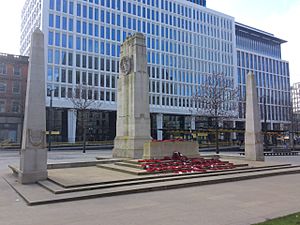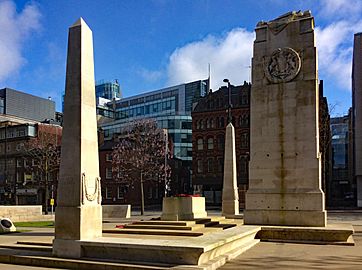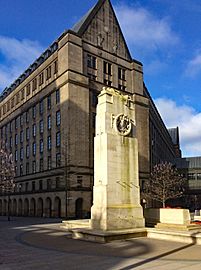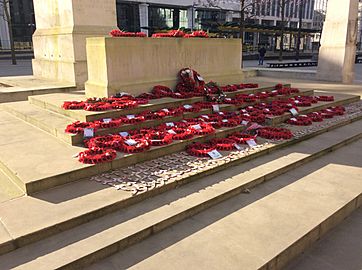Manchester Cenotaph facts for kids
Quick facts for kids The Cenotaph |
|
|---|---|
| United Kingdom | |

Manchester Cenotaph in 2017, in its new location near the town hall; looking south
|
|
| For casualties of the First World War (modified to include the Second World War and the Korean War) | |
| Unveiled | 12 July 1924 |
| Location | 53°28′43″N 2°14′34″W / 53.4787°N 2.2429°W St Peter's Square, Manchester, England
|
| Designed by | Edwin Lutyens |
|
Listed Building – Grade II
|
|
| Official name | Manchester War Memorial |
| Designated | 3 September 1974 |
| Reference no. | 1270697 |
The Manchester Cenotaph is an important war memorial in St Peter's Square, Manchester, England. It remembers the many people from Manchester who died in the First World War, and later, the Second World War and the Korean War.
Manchester was slower than other British cities to build a memorial after the First World War. A special committee was formed in 1922 to raise money and decide on a design. They quickly collected £10,000. However, choosing where to put the memorial was difficult. Many people disagreed about the best spot.
Eventually, the committee chose St Peter's Square. This area had been the site of an old church, and its burial vaults were still there. The famous architect Edwin Lutyens designed the memorial. He created a design similar to his well-known Cenotaph in London. The memorial includes a central cenotaph, a Stone of Remembrance, and two tall obelisks.
The Manchester Cenotaph was officially revealed on 12 July 1924. The Earl of Derby unveiled it, helped by Mrs. Bingle, a local mother who had lost three sons in the war. In 2014, the memorial was carefully moved to a new spot in St Peter's Square. This move made space for the growing Metrolink tram system. The Cenotaph is a special historic building, protected by law as a Grade II* listed structure.
Contents
Why Was the Manchester Cenotaph Built?
After the First World War, many towns and cities in Britain built memorials. This was because so many people had died in the war, more than ever before. Manchester contributed a huge number of soldiers to the British Army. Only London sent more recruits.
Many soldiers from Manchester joined regiments like the Manchester Regiment and the Lancashire Fusiliers. These groups included "pals battalions," where friends and neighbours from the same areas fought together. By the end of the war, over 13,000 men from the Manchester Regiment and 13,600 from the Lancashire Fusiliers had been killed. It's thought that about 22,000 people from Manchester died, and 55,000 were injured. The Cenotaph was built to honour their sacrifice.
How Was the Memorial Commissioned?
Even though the war ended in 1918, Manchester didn't start planning its memorial until 1922. The Royal British Legion, a group for ex-servicemen, pushed the city council to act. A committee was formed, led by the mayor, to decide on the memorial.
The committee set a budget of £10,000 and quickly raised the money. Donors were told that local businesses would be used for the construction. However, some ex-soldiers wrote to newspapers, saying the money should be spent on war survivors and widows who were struggling.
A newspaper owner, Edward Hulton, offered to pay for the whole memorial. But the committee said no, believing the money should come from the people of Manchester.
Choosing the Best Location
The committee looked at three possible places for the memorial: Albert Square, Piccadilly Gardens, and St Peter's Square. St Ann's Square already had a memorial to the Second Boer War, so it was ruled out.
Albert Square was the favourite, supported by the Royal British Legion. But this idea caused arguments. The Manchester Society of Architects and Manchester Art Foundation didn't want other statues in the square to be moved. Even King George V agreed to move his grandfather's memorial, but the objections continued.
The City Council then voted for Piccadilly Gardens. But this site also had problems, as there were plans for an art gallery and library there. This would delay the war memorial. So, in May 1923, the committee chose St Peter's Square instead.
St Peter's Square was also a tricky choice. It was the smallest option and had been the site of an old church, demolished in 1907. The church's burial vaults were still underground, marked by a cross. The people in charge of the church site didn't want the cross or burials moved. This disagreement was partly solved when Lutyens said his design could work with the cross and crypts still there.
Selecting the Architect
Choosing the architect also caused debate. Some groups wanted an open competition for the design. The council agreed and appointed Percy Worthington, a local architect, to judge. But the committee said they could overrule his choice, which led to criticism.
Eventually, a smaller group directly asked Sir Edwin Lutyens to design the memorial. Lutyens was a very famous architect. He had designed many war memorials, including the well-known Cenotaph in London. Manchester's Cenotaph is one of seven in England based on his London design. Lutyens also designed the huge Thiepval Memorial to the Missing in France.
What Does the Manchester Cenotaph Look Like?
Manchester's war memorial is made of Portland stone. It has a central cenotaph, which is like an empty tomb, flanked by two tall obelisks. In front of the cenotaph is a Stone of Remembrance. The whole memorial stands on a raised platform.
The cenotaph is about 32 feet (9.8 metres) tall. On top, there is a sculpture of an unknown soldier, covered by his coat, lying down. Below this, on the front and back, are carvings of swords and crowns. The sides show Manchester's coat of arms surrounded by laurel wreaths.
The cenotaph has two important inscriptions:
- "TO THE HONOURED MEMORY OF THOSE WHO GAVE THEIR LIVES FOR THEIR COUNTRY" (on the north-west side)
- "O LORD GOD OF OUR FATHERS KEEP THIS/FOREVER IN THE IMAGINATION OF THE THOUGHTS OF THE HEART OF THY PEOPLE" (on the south-east side)
The two obelisks are each about 23 feet (7.0 metres) tall. The Stone of Remembrance is a simple, long stone, about 12 feet (3.7 metres) long. It has no decorations, only the words: "THEIR NAME LIVETH FOR EVERMORE".
Lutyens' design uses simple, classic shapes rather than obvious religious symbols. The soldier on top of the cenotaph is placed high up, making him anonymous. This allows people to think of their own loved ones or imagine the idea of sacrifice.
- Views showing the constituent parts of the memorial
History of the Memorial
The area in St Peter's Square where the Cenotaph was first built already had a memorial cross. This cross, designed by Temple Moore, marked the site of the old St Peter's Church. There were disagreements about moving this cross and the burials beneath it. Lutyens said his design could work with the cross staying in place. However, during the unveiling ceremony, it became clear the cross blocked the view of the Cenotaph. Discussions continued, but the cross and burials remained.
The memorial cost £6,940 to build. It was unveiled on 12 July 1924 by Edward Stanley, 17th Earl of Derby. He was a politician who had been in charge of the War Office during the war. He was helped by Mrs. Bingle, a local woman from Ancoats. She had lost all three of her sons in the war. Her sons were Sergeant Ernest Bingle (34), Gunner Charles Bingle (27), and Corporal Nelson Bingle (21). All three died in 1918. Mrs. Bingle represented all the mothers and wives in Manchester who had made huge sacrifices.
A large crowd and a guard of honour attended the ceremony. After the unveiling, women laid flowers around the memorial. The money left over from the £10,000 raised was used to provide hospital beds for ex-servicemen and their families.
In 1949, after the Second World War, the dates for that war were added to the obelisks. The area around the memorial was turned into a garden of remembrance. Later, plaques were added to remember those who died in the Korean War and other conflicts.
Moving the Cenotaph to a New Location
Over the years, St Peter's Square changed a lot. The Metrolink tram system was built, and its tracks and power lines started to get very close to the Cenotaph. This made the area feel crowded.
In 2011, Manchester City Council asked the public what they thought about moving the Cenotaph. Some people objected, but many veterans and heritage groups supported the idea. The move was approved in 2012.
In January 2014, the Cenotaph was carefully taken apart. Each piece was cleaned and restored. The old burial crypts remained under the new tram lines, covered with concrete. The memorial cross was also cleaned and put back in its original spot above the crypts.
The Cenotaph was rebuilt in a new memorial garden on the other side of St Peter's Square. It is now lined up with the southern entrance of Manchester Town Hall. The new garden opened in September 2014. Sadly, the Cenotaph was damaged by skateboarders in its first week. Repairs were made, and extra security, including CCTV, was added.
The Manchester Cenotaph is a very important historical site. It was first listed as a Grade II building in 1985, meaning it has special interest and should be preserved. In 1994, its status was upgraded to Grade II*, which means it is a particularly important building. In 2015, it was recognized as part of a national collection of Lutyens' war memorials.
Images for kids
See also
 In Spanish: Cenotafio de Mánchester para niños
In Spanish: Cenotafio de Mánchester para niños











